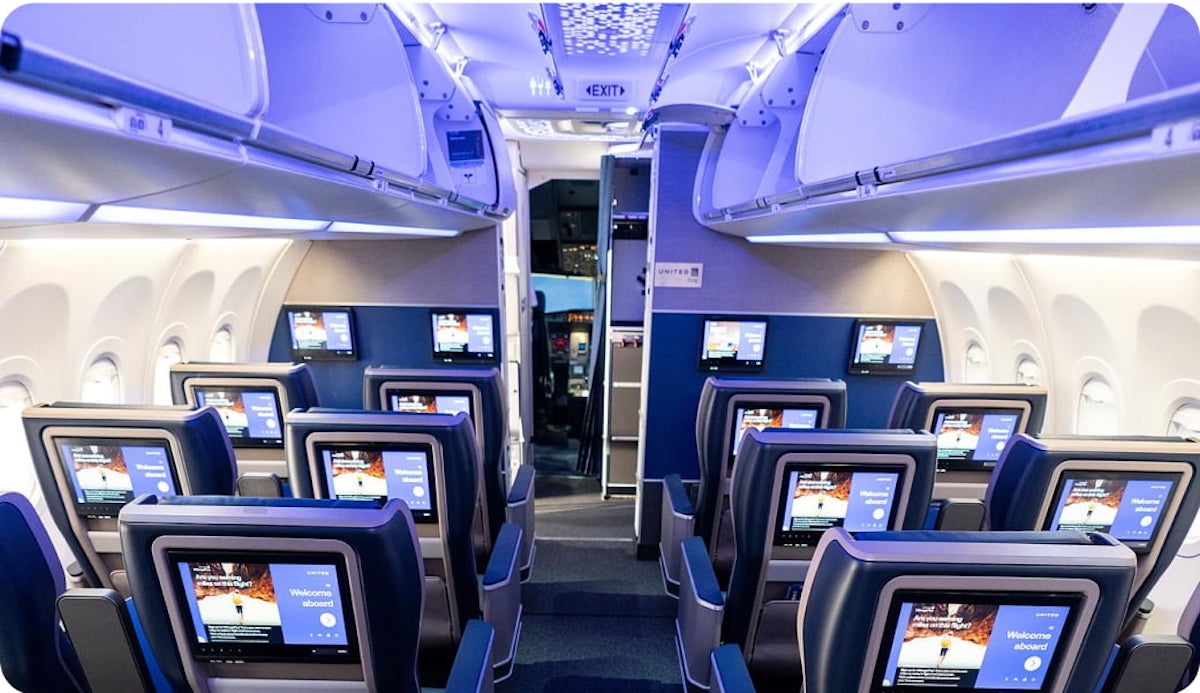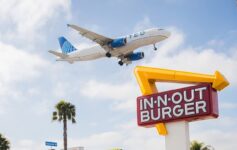
United Airlines is forecasting lower profit than initially expected this quarter, blaming domestic overcapacity. But the carrier’s annual profit target remains unchanged and it is optimistic that a course correction is in effect as other carriers plan to cut overcapacity in the months ahead, positioning United for more profit.
United Airlines Trims Profit Forecast, Sees Industrywide Correction For Domestic Overcapacity
Like Delta Air Lines announced last week, United’s projected Q2 profit will be lower than expected (between $2.75 to $3.25 per share, rather than the previously forecast $3.44/share). It blames domestic overcapacity for the lower profit, while still positioning itself with Delta in the top-tier of profitability among US carriers.
Despite the lower profitability, United CEO Scott Kirby said all is going according to plan, “At United, we have been effectively managing costs, cash, and capacity against a challenging industry backdrop because we’re focused on doing what’s necessary to hit our financial targets.”
United forecasts that the US airline industry will see an “inflection point” beginning in August during which time capacity will adjust downward (leading to higher prices for consumers in a simple supply-demand model):
For nearly two years, the airline has been anticipating significant domestic capacity reductions recently announced by a variety of U.S. airlines this summer and mid-August is an inflection point, with published schedule changes showing an approximately 3 point decline in industry capacity growth rate.
When this occurs, United cites three “critical revenue diversity advantages” that is says will propel it to further outpace its (non-Delta) rivals in terms of profitability:
- Premium revenue
- Up 8.5% in Q2 versus same quarter in 2023
- Basic economy revenue
- Up 38% year-over-year during Q2
- Increased market share among “domestic road warriors”
I don’t doubt these figures for a moment. First, we’ve seen a proliferation of basic economy fares across the route network, incentivizing more passengers to book them not just domestically, but internationally as United seeks to compete not only with Spirit and Frontier in the USA, but also carriers like Norse Atlantic across the ocean.
Second, I am the perfect example of how United was able to increase premium revenue. Domestic upgrades are virtually non-existent anymore as a Premier 1K member. Indeed, I earn 1K status because I tend to buy front-cabin seats these days rather than what used to drive me to 1K status: upgrades. Even though I’m largely off the status hamster wheel (I’ll fly what makes sense these days), I still fly enough and prefer United to keep the status.
United will host an earnings call later today and we’ll listen to what Kirby and the rest of the C-Suite have to say. But it does merit mentioning that Kyle was right on when he noted many weeks ago what appeared to be an industrywide slowdown from the “heyday” of revenge travel.
United hopes that others will cut back service while it continues to expand: that’s an interesting gamble. While United hopes to gain more market share and drive most cost savings through the synergies of a larger and newer fleet, it may be that Boieng delivery delays continue to be a blessing in disguise in a market that appears, at least for the moment, to be saturated.
CONCLUSION
United Airlines expects healthy Q2 profits, though lower than originally forecast. But with a course correction coming as the summer travel season draws to a close, United hopes that reduced capacity will drive higher margins for its operations. United has been able to capture both ends of the market with more premium fares and more basic economy fares, pointing out the advantage it it has over budget carriers to offer a wider range of products (not to mention a worldwide route map).
> Read More:Why United Airlines Is Profitable And Budget Carriers Are Losing Money
image: United Airlines




I’ve flown United twice this summer. I have free Silver status through Marriott. My upgrades cleared on both flights, so I am at 100% on United upgrades this year. I say extra capacity is GREAT!
Are you serious? What routes? AUS-IAH?
AUS-IAH (though, I flew it at 19:48 on 4-JUL)
IAH- HRL (19:00 departure on a Thursday. This one surprised me)
United Airlines is under-represented in domestic market. Unlike DL or AA, UA should increases frequency/capacity. Case in point, UA only has 2 daily flights from Tucson to Denver, UA’s largest hub. AA has 6 daily flights between Tucson and Dallas, and AA flight is longer.
Yes, UA did well and is finally reaching comparable levels of profitability as DL– but let’s not forget that UA set the goal of reaching DL’s profitability 7 years ago when he moved to UA. Obviously the pandemic interrupted a lot and he has learned from the mistakes of others and his own mistakes (which have not been just a few at AA, US and HP) but he also is succeeding because he is doing many things that DL did first and provided a template for him and UA.
As for the actual numbers:
– DL and UA posted very similar revenue numbers. DL is slightly better in RASM improvement in every region except Latin America where the chances are that Latam gets lower average fares than DL and is making it harder for DL to increase RASM.
– DL’s system passenger revenue was higher than UA’s with UA generating higher cargo revenue and DL handedly winning in “other” revenue which includes loyalty/credit card revenue.
– DL is still far larger domestically and UA internationally but the two are moving more in the direction of having networks like each other.
– UA always does better in the 2nd and 3rd quarter than they do in the 1st and 4th quarters because they are not near as strong to the Caribbean. They, like AS, are trying to fix their seasonality but DL is expected to still deliver higher annual profits than UA because of winter strength which UA does not have.
– DL’s results compared to last year were impacted by lower jet fuel crack spreads which means the refinery did not contribute as big of a benefit this year as it has since the beginning of post-covid recovery. And yet DL says it intends to keep the refinery – because it provides a hugely valuable insurance policy and is not losing money – it is just not delivering as much of a jet fuel price benefit to DL – but still more than 10 cents even this quarter.
– DL also took a hit on its equity investments of $200 million. There was discussion about DL’s equity investments and this shows that DL is a financially stronger and more stable airline than its equity partners and their performance does impact DL’s bottom line.
– DL also noted that the Olympics are costing it about $100 million in revenue in Paris; LH reduced their guidance so the rest of continental Europe may be softening as much as Paris but UA has so far not said that.
– The biggest cost difference remains that UA, like AA, has not settled with its FAs while DL has increased its FA and all personnel salaries once again. AS also just reported and said that their new FA contract will hurt 3rd quarter earnings and it is certain that UA will take a hit, esp. given that retro for AA and UA could hit the better part of $1 billion – not unlike what was paid to the pilots who settled even before profits started to increase.
And UA also noted that it will not hit 1000 mainline aircraft this year – in line with what DL is saying. UA will retire a few 319/320s and a few RJs but will also only get about 25 more MAXs for the rest of the year, 4 787s, and 18 or so 321s. The huge influx of capacity at UA is not happening and probably won’t happen next year but is keeping capacity growth down and allowed UA to pay down debt, something it could not have done if it took as many planes as it wanted.
DL and UA are still growing at similar rates which says that DL can deliver growth even with a smaller order book and less financial exposure. DL’s credit rating was increased by Fitch this week so it will reduce their borrowing costs.
DL will receive substantially more widebodies over the next couple of years which means international growth for DL is likely to be higher than domestic growth for UA.
DL’s Amex relationship continues to be the big differentiator in total revenue; MRO revenue is flat due to parts shortages. Both will increase faster than UA’s non-transportation revenue.
And now the rest of the industry will report and none of them will have numbers near as good as AS, DL and UA.
Get lost. You ruin OMAT, we don’t want you here either
Tim “I don’t use this trash blog” Dunn
Seems a lot like a sorry, not sorry from Kirby. Instead of “We put too many planes in the air.” he blames competitors for doing the same thing he chose to do.
Come to think of it, I certainly haven’t seen any evidence of this theoretical overcapacity. Has anyone else been experiencing easy free upgrades and/or lots of empty seats on their flights?
Major flights cuts at Frontier, Spirit and Jet Blue have been posted. Kirby is spot on